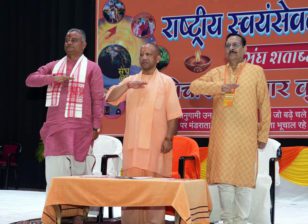Debunking Hindu American Foundation’s Misinformation on Citizenship Amendment Act
The Indian Government’s Citizenship Amendment Act (CAA) was passed into law in December 2019, amending critical aspects of India’s Citizenship Act, 1955. The rules under Act, Citizenship Amendment Rules, 2024 (the CAA Rules) were then notified (or officially implemented) in March, 2024. The law makes a provision of citizenship for “… any person belonging to Hindu, Sikh, Buddhist, Jain, Parsi or Christian community from Afghanistan, Bangladesh or Pakistan…” who entered India before 1st January 2015. The rules put in place the procedure for an application.
Since its first announcement, the CAA has drawn intense criticism for how it links citizenship to religious faith, and pointedly excludes Muslims from its list of religions. International human rights groups have warned that the CAA, when coupled with the National Register of Citizens (NRC), an official listing of all Indian citizens, poses a grave threat to the rights of over 200 million Indian Muslims, potentially resulting in the stripping of citizenship from those lacking decades-old documentation.
In recent years, the Hindu America Foundation (HAF), the U.S.-based Hindu nationalist advocacy group, has aggressively promoted and defended the CAA while promoting the Indian government’s talking points. With the CAA’s recent implementation in India, HAF has once again issued a series of arguments defending the law’s legitimacy.
HAF’s arguments in defense of the CAA are fundamentally flawed and deceptive. This article addresses their arguments one by one.
HAF Myth: The Citizenship Amendment Act (CAA) “provides amnesty and a fast-track to citizenship for certain refugees currently in India who have fled religious persecution in Afghanistan, Bangladesh and [or] Pakistan…”
FACT: The CAA is not a refugee legislation. No law or legislation in India mentions refugees. The CAA does not either. The Refugee Convention, of 1955 lays down the international framework for refugees. India is not a state party to the convention. Under international law and the domestic laws of countries that have a legal framework for refugees (such as the United States under the Immigration and Nationality Act) a person seeking asylum and subsequent refugee status is required to establish that they have a “well-founded fear of being persecuted for reasons of race, religion, nationality, membership of a particular social group, or political opinion.” Under the Indian law, the categories of persons mentioned therein, that is Hindu, Sikh, Buddhist, Jain, Parsi or Christian community from Afghanistan, Bangladesh or Pakistan, are not granted refugee status at any stage. They are merely granted Indian citizenship. These are two very different legal statuses.
Persecution is not a reason defined by the law or weaved into it. While the Statement of Objects and Reasons under the Act, which is not enforceable, mentions persecution, the same finds no mention in the law. Persecution or the fear of persecution is not a standard under the law. The law does more, albeit extremely problematically, for recognizing India as the place for “Dharmic/ Indic traditions” than creating refugee legislation in India.
Calling CAA a refugee legislation takes away from the need for refugee legislation in India. It gives the illusion of a stop-gap measure for refugees, which it is not. If two people have both come from Bangladesh for economic reasons and without documents, and one happens to be Hindu and the other Muslim, the Hindu can now become a citizen, but the Muslim has no recourse. The law does not mandate that the Hindus from Bangladesh must show persecution, which is usually a very specific legal requirement.
Onerous documentary proof of persecution has problems of its own, however, the CAA, in the documentary burdens it imposes neither solves that problem, nor fills a gap in creating standards for refugees seeking asylum in India. It fails refugee law parameters on both accounts.
HAF Myth: The CAA does not, “…establish any religious test for immigration or exclude Muslims from immigrating to India.” The “… current proposal does not establish a religious test.”
FACT: The CAA Rules explicitly demand proof of belonging to a particular religious community. To establish eligibility for citizenship under the Amendment, a petitioner must provide the following documents to establish eligibility under the CAA:
- Proof of coming from Afghanistan, Bangladesh or Pakistan;
- Proof that they came to India on or before 31st December, 2014; and
- Proof that they belong to one of the religions mentioned therein, being an affidavit from a “reputed community institution.”
Therefore, to become eligible for Indian citizenship, one has to prove proof of their religious affiliation, making religion one of the three explicit prongs of the test under the CAA.
HAF Myth: The CAA “does not alter the rights of any Indian citizen”
Fact: The CAA creates a dangerous precedent of acquiring Indian citizenship through a religious basis. While CAA on its own is problematic and unconstitutional, its government-intended execution as a complement to the NRC will be even more disastrous. The NRC’s rollout in August 2019 in the northeastern state of Assam saw 1.9 million individuals excluded from the list of Indian citizens, effectively rendering them stateless. Indian Home Minister Amit Shah has repeatedly stated his government’s intention to implement the CAA before conducting a nationwide NRC exercise, purportedly to “detect and deport every infiltrator from our motherland.” Under this system, Hindus excluded from the NRC could ostensibly gain citizenship through the CAA. Conversely, any Muslim lacking proper documentation faces the presumption of being an “infiltrator” and subsequent loss of citizenship.
HAF Myth: The CAA in India is akin to the Lautenberg Amendment in the US
Fact: The CAA cannot be equated to the Lautenberg Amendment. The first and foremost difference, inter alia, is the recognition of refugees under the law. Indian law does not recognize refugees—not even under the CAA. India only has ad hoc policies for refugees like Tibetan refugees. It has no refugee law.
In the US, on the other hand, the Immigration and Nationality Act lays down the detailed Asylum seeking and Refugee determination processes. The US is also a state party to the Refugee Convention. Indian law, including the CAA, does not mention (a) refugees; or (b) persecution as a standard of determination of refugee status. In the absence of a legal framework for Refugees and the very existence of the legal recognition of people seeking refuge, the law in India cannot be compared to the US Lautenberg Amendment because while the former does not recognize refugees, the latter is made specifically for refugees.
The second difference is that since Indian law does not recognize refugees, this law provides a direct path to citizenship, without the determination of one’s status as a refugee. The Lautenberg Amendment specifically functions under a refugee admissions category and is limited only to those who wish to join their families in the United States. They have to meet the fear of persecution standard, albeit under the reduced evidentiary burden.
The final difference is how the law is operationalized and implemented. The Lautenberg Amendment is administered through the US Refugee Admissions Program (USRAP), a special program for refugees. Determination of refugee status is a specialized skill and therefore needs to be made by specialists. The entire process of granting citizenship under the CAA is carried out under the Home Ministry by State and District Level Committees (SLEC & DLC). The members of these committees include personnel from the Intelligence Bureau, Informatics Centers, Postal Officer, Railways officer, and one officer from the Foreigner Regional Registration officer (that too only at the State level). Therefore, the bodies and personnel making the determination under the two amendments differ in their entirety and mandate – while one is a special refugee determination agency, the other is a committee of existing bureaucrats with multiple other roles, of granting citizenship.




